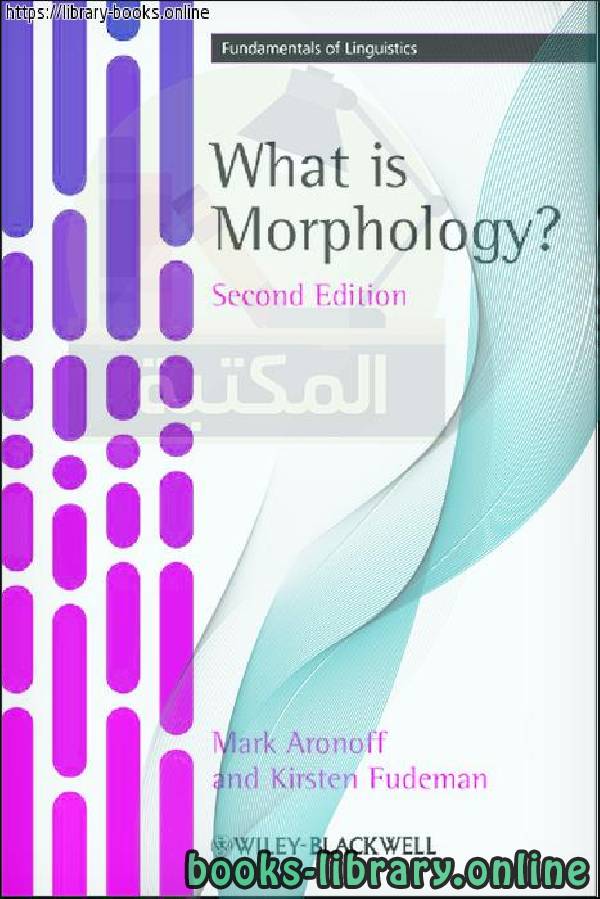📘 قراءة كتاب What Is Morphology أونلاين


هذا القسم يحتوي علي كل ما يخص بعلم الصرف
يتوفر علم الصرف على تبيان تأليف الكلمة المفردة بتبيان وزنها وعدد حروفها و حركاتها و ترتيبها، و ما يعرض لذلك من تغيير وحذف، وما في حروفها و حركاتها و ترتيبهما، وما في حروف الكلمة من اصالة و زيادة.
يقتصر مجال دراسات الصرف على الأسماء المتمكنة (المعربة) و الافعال المتصرفة (غير جامدة).
أما الحروف و مبنيات الأسماء و جوامد الافعال، فلا تدخل في مجال دراسته و أبحاثه.
يُعرَفُ الصرف أيضا بعلم التشكل (باللاتينية: Morphologia). والصرف لُغَةً هو التغير والتحويل ومنه تصريف الرياح أي تغيير وجهتها من مكان لآخر.
In linguistics, morphology (/mɔːrˈfɒlədʒi/) is the study of words, how they are formed, and their relationship to other words in the same language. It analyzes the structure of words and parts of words, such as stems, root words, prefixes, and suffixes. Morphology also looks at parts of speech, intonation and stress, and the ways context can change a word's pronunciation and meaning. Morphology differs from morphological typology, which is the classification of languages based on their use of words, and lexicology, which is the study of words and how they make up a language's vocabulary.]
While words, along with clitics, are generally accepted as being the smallest units of syntax, in most languages, if not all, many words can be related to other words by rules that collectively describe the grammar for that language. For example, English speakers recognize that the words dog and dogs are closely related, differentiated only by the plurality morpheme "-s", only found bound to noun phrases. Speakers of English, a fusional language, recognize these relations from their innate knowledge of English's rules of word formation. They infer intuitively that dog is to dogs as cat is to cats; and, in similar fashion, dog is to dog catcher as dish is to dishwasher. By contrast, Classical Chinese has very little morphology, using almost exclusively unbound morphemes ("free" morphemes) and depending on word order to convey meaning. (Most words in modern Standard Chinese ["Mandarin"], however, are compounds and most roots are bound.) These are understood as grammars that represent the morphology of the language. The rules understood by a speaker reflect specific patterns or regularities in the way words are formed from smaller units in the language they are using, and how those smaller units interact in speech. In this way, morphology is the branch of linguistics that studies patterns of word formation within and across languages and attempts to formulate rules that model the knowledge of the speakers of those languages.
Phonological and orthographic modifications between a base word and its origin may be partial to literacy skills. Studies have indicated that the presence of modification in phonology and orthography makes morphologically complex words harder to understand and that the absence of modification between a base word and its origin makes morphologically complex words easier to understand. Morphologically complex words are easier to comprehend when they include a base word.[6]
Polysynthetic languages, such as Chukchi, have words composed of many morphemes. The Chukchi word "təmeyŋəlevtpəγtərkən", for example, meaning "I have a fierce headache", is composed of eight morphemes t-ə-meyŋ-ə-levt-pəγt-ə-rkən that may be glossed. The morphology of such languages allows for each consonant and vowel to be understood as morphemes, while the grammar of the language indicates the usage and understanding of each morpheme.
The discipline that deals specifically with the sound changes occurring within morphemes is morphophonology.
What Is Morphology
Praise for What is Morphology?
“Aronoff and Fudeman have produced a clear and jargon-free introduction
to contemporary morphological theory and practice. The book succeeds
particularly in clarifying the empirical content, organizational principles
and analytic techniques that distinguish morphology from other areas
of linguistics.”
James P. Blevins, University of Cambridge
“This book offers abundant examples of morphological data and
illuminating guidance through the classic and fundamental problems
of morphological analysis. Any student who has worked through this
book will really know what morphologists do, and how they go about
doing it . . . I consider What Is Morphology? an indispensable introduction
to the subject.”
Martin Maiden, FBA,
Professor of the Romance Languages Faculty of Linguistics
Praise for Previous Edition
“Aronoff and Fudeman have provided an extremely pleasant tour of
the issues in modern morphological theory for beginning students. The
rich collection of exercises will be a godsend to instructors and students
alike, and the thread of discussion of a single language throughout the
book is a brilliant stroke that other texts should emulate.”
Stephen R. Anderson, Yale University
“This unusual book combines a basic start on morphology with an
introduction to Kujamaat Jóola. It is a fine addition to teaching materials
on morphology: a book for beginners to use with a teacher, yet one from
which any linguist could learn. The authors intend students to develop
‘a lasting taste for morphology’. I think many will.”
Greville Corbett, University of Surrey, Guildford
“Morphology has its own organizing principles, distinct from those of
syntax, phonology, and the lexicon. Too many morphology textbooks
obscure this fascinating fact, but Aronoff and Fudeman refreshingly
make it the cornerstone of their exposition.”
Andrew Carstairs-McCarthy, University of Canterbury
Contents
Preface viii
Acknowledgments xiv
Abbreviations xv
Remarks on Transcription xviii
The International Phonetic Alphabet xx
1 Thinking about Morphology and Morphological Analysis 1
1.1 What is Morphology? 1
1.2 Morphemes 2
1.3 Morphology in Action 4
1.4 Background and Beliefs 10
1.5 Introduction to Morphological Analysis 12
1.6 Summary 22
Introduction to Kujamaat Jóola 23
Further Reading 26
Exercises 27
2 Words and Lexemes 33
2.1 What is a Word? 34
2.2 Empirical Tests for Wordhood 38
2.3 Types of Words 40
2.4 Inflection vs. Derivation 47
2.5 Two Approaches to Morphology:
Item-and-Arrangement, Item-and-Process 49
2.6 The Lexicon 54
What Is Morphology
types of morphology
morphology pdf
morphology examples
morphology exercises with answers pdf
introduction to morphology
what is syntax
what is morpheme
semantics
سنة النشر : 2011م / 1432هـ .
حجم الكتاب عند التحميل : 2.6MB .
نوع الكتاب : pdf.
عداد القراءة:
اذا اعجبك الكتاب فضلاً اضغط على أعجبني و يمكنك تحميله من هنا:

شكرًا لمساهمتكم
شكراً لمساهمتكم معنا في الإرتقاء بمستوى المكتبة ، يمكنكم االتبليغ عن اخطاء او سوء اختيار للكتب وتصنيفها ومحتواها ، أو كتاب يُمنع نشره ، او محمي بحقوق طبع ونشر ، فضلاً قم بالتبليغ عن الكتاب المُخالف:
 قبل تحميل الكتاب ..
قبل تحميل الكتاب ..
يجب ان يتوفر لديكم برنامج تشغيل وقراءة ملفات pdf
يمكن تحميلة من هنا 'http://get.adobe.com/reader/'


 منصّة المكتبة
منصّة المكتبة 